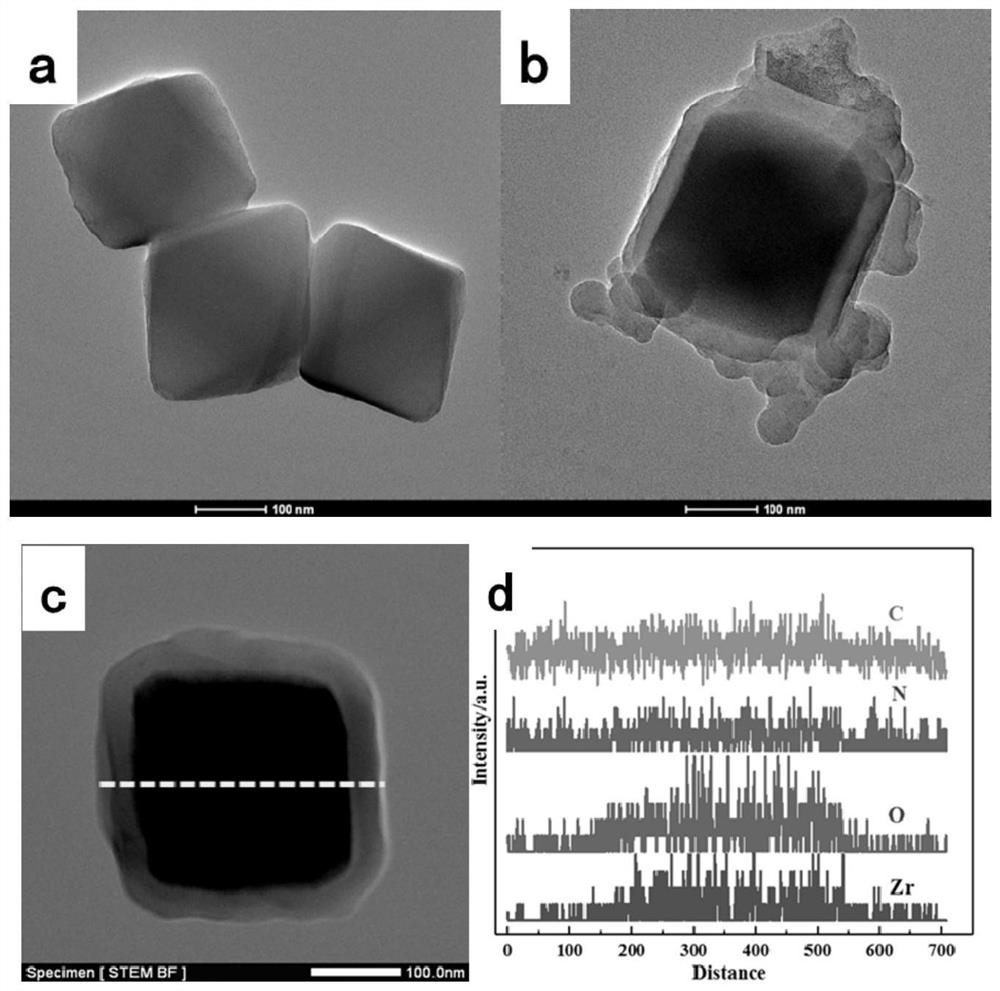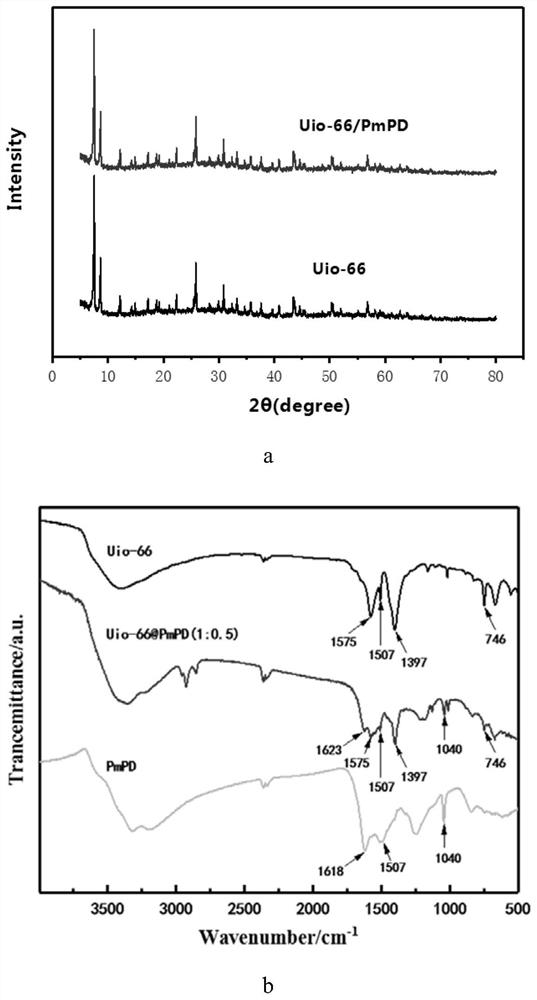Application of a uio-66/polyaromatic composite material
A technology of uio-66 and composite materials, which is applied in the field of environmental engineering, can solve the problems of low specific surface area and limited application of polyarylamine, and achieve the effects of low cost, improved adsorption performance, and improved oxidation polymerization efficiency
- Summary
- Abstract
- Description
- Claims
- Application Information
AI Technical Summary
Problems solved by technology
Method used
Image
Examples
Embodiment 1
[0067] Accurately weigh 600mg Uio‐66 and add it to a 250ml round bottom flask, add 150ml distilled water and stir and ultrasonically disperse, then accurately weigh 300mg m-phenylenediamine monomer and 300mg sodium dodecyl sulfonate and add to the above flask , Stir for 16h to make full contact. Accurately weigh 900mg of sodium persulfate and dissolve it in 50ml of distilled water to fully dissolve it, and take 37ml for use. Within about 15 minutes, the sodium persulfate solution was gradually added dropwise to the round bottom flask to initiate oxidative polymerization. The above reaction continued for 5 hours at room temperature (about 20°C), and the reaction system gradually changed from white to dark brown. After the reaction, it is obtained by centrifugal separation (rotational speed is 8000 rpm), and the residual sodium persulfate and sodium dodecyl sulfonate are washed away with distilled water. The product was dried in an oven for 12 hours, and the resulting black sol...
Embodiment 2
[0069] Accurately weigh 200mg Uio‐66 and add it to a 250ml round bottom flask, add 150ml of distilled water and stir and ultrasonically disperse, then accurately weigh 600mg of m-phenylenediamine monomer and 200mg of sodium dodecyl sulfonate and add to the above flask , Stir for 16h to make full contact. Accurately weigh 1.8g of sodium persulfate and dissolve it in 50ml of distilled water to fully dissolve it, and take 37ml for use. Within about 15 minutes, the sodium persulfate solution was gradually added dropwise to the round bottom flask to initiate oxidative polymerization. The above reaction continued for 5 hours at room temperature (about 20°C), and the reaction system gradually changed from white to dark brown. After the reaction, it is obtained by centrifugal separation (rotational speed is 8000 rpm), and the residual sodium persulfate and sodium dodecyl sulfonate are washed away with distilled water. The product was dried in an oven for 12 hours, and the black solid...
Embodiment 3
[0071] Accurately weigh 200mg Uio‐66 and add it to a 250ml round bottom flask, add 150ml distilled water and stir and ultrasonically disperse, then accurately weigh 200mg m-phenylenediamine monomer and 200mg sodium dodecyl sulfonate and add it to the above flask , Stir for 16h to make full contact. Accurately weigh 600mg of sodium persulfate and dissolve it in 50ml of distilled water to fully dissolve it, and take 37ml for use. Within about 15 minutes, the sodium persulfate solution was gradually added dropwise to the round bottom flask to initiate oxidative polymerization. The above reaction continued for 5 hours at room temperature (about 20°C), and the reaction system gradually changed from white to dark brown. After the reaction, it is obtained by centrifugal separation (rotational speed is 8000 rpm), and the residual sodium persulfate and sodium dodecyl sulfonate are washed away with distilled water. The product was dried in an oven for 12 hours, and the black solid powd...
PUM
| Property | Measurement | Unit |
|---|---|---|
| specific surface area | aaaaa | aaaaa |
| specific surface area | aaaaa | aaaaa |
| adsorption capacity | aaaaa | aaaaa |
Abstract
Description
Claims
Application Information
 Login to View More
Login to View More - R&D
- Intellectual Property
- Life Sciences
- Materials
- Tech Scout
- Unparalleled Data Quality
- Higher Quality Content
- 60% Fewer Hallucinations
Browse by: Latest US Patents, China's latest patents, Technical Efficacy Thesaurus, Application Domain, Technology Topic, Popular Technical Reports.
© 2025 PatSnap. All rights reserved.Legal|Privacy policy|Modern Slavery Act Transparency Statement|Sitemap|About US| Contact US: help@patsnap.com



